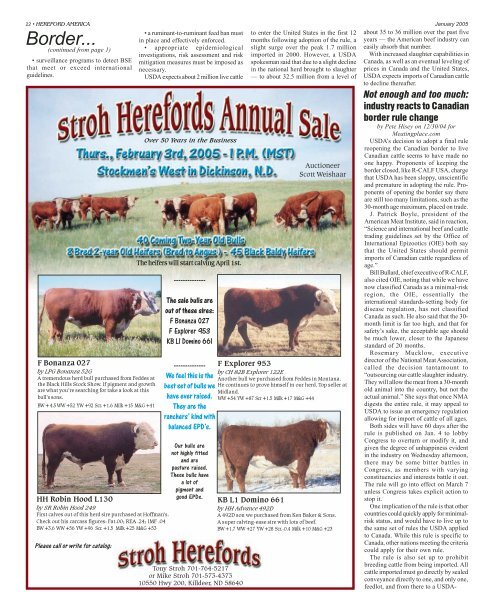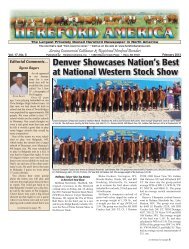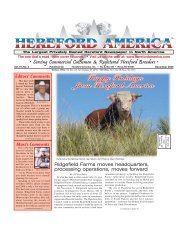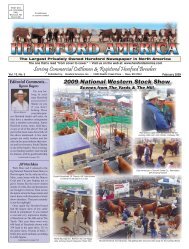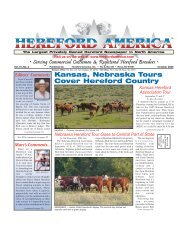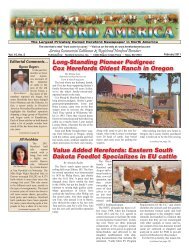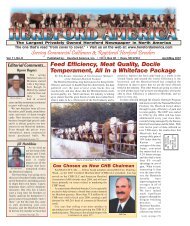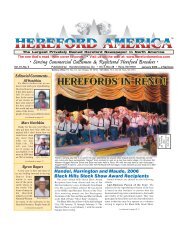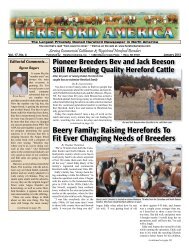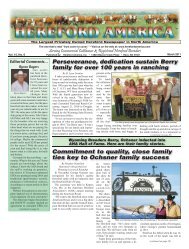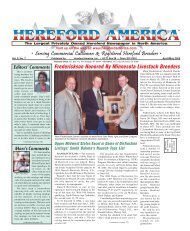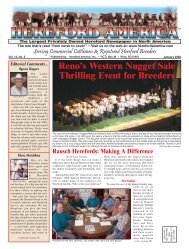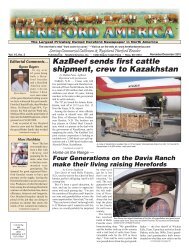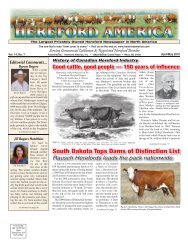January 2005 Section A (pdf - 14702 kb)... - Hereford America
January 2005 Section A (pdf - 14702 kb)... - Hereford America
January 2005 Section A (pdf - 14702 kb)... - Hereford America
You also want an ePaper? Increase the reach of your titles
YUMPU automatically turns print PDFs into web optimized ePapers that Google loves.
22 • HEREFORD AMERICA <strong>January</strong> <strong>2005</strong><br />
Border...<br />
(continued from page 1)<br />
• surveillance programs to detect BSE<br />
that meet or exceed international<br />
guidelines.<br />
F Bonanza 027<br />
by LPG Bonanza 52G<br />
A tremendous herd bull purchased from Feddes at<br />
the Black Hills Stock Show. If pigment and growth<br />
are what you’re searching for take a look at this<br />
bull’s sons.<br />
BW + 4.5 WW +52 YW +92 Scr. +1.6 Milk +15 M&G +41<br />
--------------<br />
The sale bulls are<br />
out of these sires:<br />
F Bonanza 027<br />
F Explorer 953<br />
KB L1 Domino 661<br />
--------------<br />
We feel this is the<br />
best set of bulls we<br />
have ever raised.<br />
They are the<br />
ranchers’ kind with<br />
balanced EPD’s.<br />
Our bulls are<br />
not highly fitted<br />
and are<br />
pasture raised.<br />
These bulls have<br />
a lot of<br />
pigment and<br />
HH Robin Hood L130<br />
good EPDs.<br />
by SR Robin Hood 249<br />
First calves out of this herd sire purchased at Hoffman’s.<br />
Check out his carcass figures: Fat.00; REA .24; IMF .04<br />
BW +3.6 WW +56 YW +96 Scr. +1.5 Milk +25 M&G +53<br />
Please call or write for catalog:<br />
• a ruminant-to-ruminant feed ban must<br />
in place and effectively enforced.<br />
• appropriate epidemiological<br />
investigations, risk assessment and risk<br />
mitigation measures must be imposed as<br />
necessary.<br />
USDA expects about 2 million live cattle<br />
Over 50 Years in the Business<br />
The heifers will start calving April 1st.<br />
Tony Stroh 701-764-5217<br />
or Mike Stroh 701-573-4373<br />
10550 Hwy 200, Killdeer, ND 58640<br />
to enter the United States in the first 12<br />
months following adoption of the rule, a<br />
slight surge over the peak 1.7 million<br />
imported in 2000. However, a USDA<br />
spokesman said that due to a slight decline<br />
in the national herd brought to slaughter<br />
— to about 32.5 million from a level of<br />
Auctioneer<br />
Scott Weishaar<br />
F Explorer 953<br />
by CH 82B Explorer 122E<br />
Another bull we purchased from Feddes in Montana.<br />
He continues to prove himself in our herd. Top seller at<br />
Midland.<br />
WW +54 YW +87 Scr +1.5 Milk +17 M&G +44<br />
KB L1 Domino 661<br />
by HH Advance 492D<br />
A 492D son we purchased from Ken Baker & Sons.<br />
A super calving-ease sire with lots of beef.<br />
BW +1.7 WW +27 YW +28 Scr. -0.4 Milk +10 M&G +23<br />
about 35 to 36 million over the past five<br />
years — the <strong>America</strong>n beef industry can<br />
easily absorb that number.<br />
With increased slaughter capabilities in<br />
Canada, as well as an eventual leveling of<br />
prices in Canada and the United States,<br />
USDA expects imports of Canadian cattle<br />
to decline thereafter.<br />
Not enough and too much:<br />
industry reacts to Canadian<br />
border rule change<br />
by Pete Hisey on 12/30/04 for<br />
Meatingplace.com<br />
USDA’s decision to adopt a final rule<br />
reopening the Canadian border to live<br />
Canadian cattle seems to have made no<br />
one happy. Proponents of keeping the<br />
border closed, like R-CALF USA, charge<br />
that USDA has been sloppy, unscientific<br />
and premature in adopting the rule. Proponents<br />
of opening the border say there<br />
are still too many limitations, such as the<br />
30-month age maximum, placed on trade.<br />
J. Patrick Boyle, president of the<br />
<strong>America</strong>n Meat Institute, said in reaction,<br />
“Science and international beef and cattle<br />
trading guidelines set by the Office of<br />
International Epizootics (OIE) both say<br />
that the United States should permit<br />
imports of Canadian cattle regardless of<br />
age.”<br />
Bill Bullard, chief executive of R-CALF,<br />
also cited OIE, noting that while we have<br />
now classified Canada as a minimal-risk<br />
region, the OIE, essentially the<br />
international standards-setting body for<br />
disease regulation, has not classified<br />
Canada as such. He also said that the 30-<br />
month limit is far too high, and that for<br />
safety’s sake, the acceptable age should<br />
be much lower, closer to the Japanese<br />
standard of 20 months.<br />
Rosemary Mucklow, executive<br />
director of the National Meat Association,<br />
called the decision tantamount to<br />
“outsourcing our cattle slaughter industry.<br />
They will allow the meat from a 30-month<br />
old animal into the country, but not the<br />
actual animal.” She says that once NMA<br />
digests the entire rule, it may appeal to<br />
USDA to issue an emergency regulation<br />
allowing for import of cattle of all ages.<br />
Both sides will have 60 days after the<br />
rule is published on Jan. 4 to lobby<br />
Congress to overturn or modify it, and<br />
given the degree of unhappiness evident<br />
in the industry on Wednesday afternoon,<br />
there may be some bitter battles in<br />
Congress, as members with varying<br />
constituencies and interests battle it out.<br />
The rule will go into effect on March 7<br />
unless Congress takes explicit action to<br />
stop it.<br />
One implication of the rule is that other<br />
countries could quickly apply for minimalrisk<br />
status, and would have to live up to<br />
the same set of rules the USDA applied<br />
to Canada. While this rule is specific to<br />
Canada, other nations meeting the criteria<br />
could apply for their own rule.<br />
The rule is also set up to prohibit<br />
breeding cattle from being imported. All<br />
cattle imported must go directly by sealed<br />
conveyance directly to one, and only one,<br />
feedlot, and from there to a USDA-


